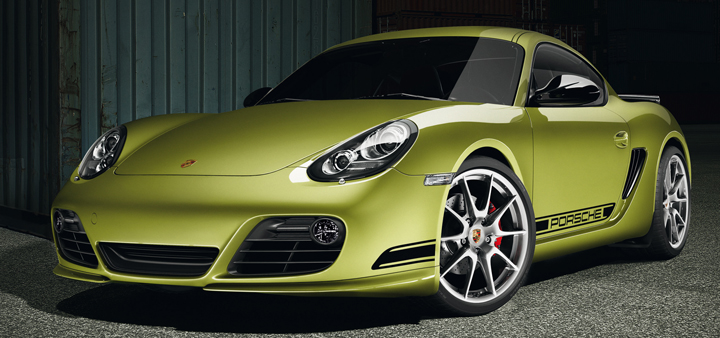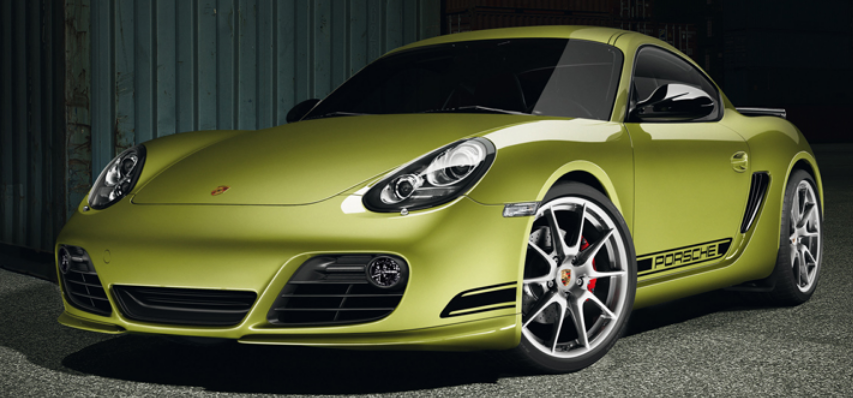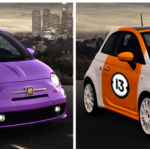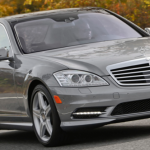
Note: This report supplements Consumer Guide Automotive’s full report on the 2012 Porsche Cayman, a premium sporty/performance car that starts at $51,900.
Meet the Millionth Porsche 911
Test car was equipped with: auto-dim mirrors, PCM/navigation system, bi-xenon headlamps, Sound Package Plus, auto climate control, Sport Chrono Plus Package, satellite radio, universal audio interface, black-painted wheels. Total MSRP with $950 destination = $79,285.
Powertrain: 330-hp 3.4-liter horizontally opposed 6-cylinder engine, 6-speed manual transmission.
Acceleration: Motor Trend quotes Porsche’s 0-60 mph Cayman R claims of 4.7 sec with 6-speed manual (as on my tester) and 4.4 with the optional 7-speed PDK dual-clutch automatic; Car and Driver timed the latter at 4.2. This test car didn’t feel quite as quick as Porsche says, but maybe my pants-seat needed recalibrating. Anyway, the Cayman R feels ferocious off the line and plenty fast in most every situation, so it deserves an “8” and maybe a “9” in this category. The engine is very revvy but not peaky—nice. Depending on road speed, the Cayman R pulls quite smoothly and with fair gusto in 3rd, 4th, and even 5th gear. Acceleration is helped by final gearing that seems on the “short” side (numerically high ratio); the tachometer shows 3000 rpm at steady 70 mph in 6th.
Fuel Economy: The test car averaged 16.3 mpg for some 61 miles of Phoenix-area driving that was split about 40/60 city/freeway. I wish I had the chance to drive it more miles and in more varied conditions. The EPA says 19/27 mpg city/highway, making my result a little disappointing by that metric.
Ride Quality: The test car came on staggered-width Michelin Pilot Sport 2 N2 performance tires: 235/35ZR19-87Y front, 265/35ZR19-94Y rear. We rate the related Boxster convertible with size 19 shoes as “3” for ride comfort. Would say this Cayman deserves the same, perhaps even “2.” If anything, its ride is even more rough-and-tumble than I remember from my last Boxster: jiggly, thumpy, and harsh, with little apparent spring/shock compliance. It’s not bad for a “track day special,” but for me it’s rather tiring, even around town on mostly smooth Arizona pavement.
Steering/handling/braking: We give Boxsters a “10” here, so this Cayman probably deserves an “11” by dint of its stiffer suspension and stiffer coupe structure, plus high-po footwear. The R corners virtually flat and gives the impression of great stick, though I suspect the tail will flick out under full power, especially with the stability/trac system turned off and/or on wet pavement. Steering is a bit heavy at low speeds, but well-nigh perfect otherwise: quick and direct with exemplary feel, yet with little of the usual kickback traditional in Porsche’s rear-engine 911 sports cars. Brakes are excellent, as expected of Porsche.
Quietness: Our comments and rating (“3”) for the related 2012 Boxer would apply here too, though I suspect the Cayman R is a tad noisier because of its sport-tuned exhaust and more-aggressive tires.
Controls: Here, too, the Cayman would come in for the same comments and rating (“5”) notes as in our full 2012 Porsche Boxster report. I didn’t play much with the tester’s nav system, but the touchscreen is too small for my liking and subject to easy washout in even moderately strong daylight. The navigation controls are similar to those in other Porsches and thus not the most intuitive. And there’s no voice control, a huge omission at this price point. A single steering-column stalk controls the trip computer, Sport Chrono operation, and such functions; I never did quite master its “logic.” The selected settings show on an inset at the base of the tachometer, but I found the display lacking in contrast and hard to read.
Details: Again, most of what we say about the Boxster applies here, as does the “8” rating. The Cayman R is literally “detrimmed” versus the regular and S versions, though it’s not apparent without one of those next door for comparison. Minimizing weight is the reason, a la the recent, limited-edition Boxster Spyder. That also explains why Cayman R buyers pay extra for air, stereo, and other expected no-cost amenities, though the tester did come with a “standard leather interior.” Several friends commented on the nylon pull-straps that substitute for interior door handles on the R, a weight-saving measure and a rather silly one in my view. Worse, the owner is in for a big pain if those straps are cut or jammed.
Room/comfort (front): The related 2012 Boxster rates a “4” in this category for having a snug, low-slung cockpit that is just roomy enough for two 6-footers. All that naturally applies to Cayman models, but note that the R includes firm, bolstered sport seats that may feel too hard and huggy for some folks. The test car came with a power backrest recliner, which I appreciated, but other seat adjustments were manual (including height). Seat travel was more than adequate for my long-legged 6-foot frame, but because the pedals sit way forward and have long strokes, I had to sit closer to the wheel than I would have liked. It was just as well, because the rear cockpit bulkhead more or less precludes a laid-back posture for taller drivers. Unlike a top-up Boxster, Cayman visibility is quite good over the shoulder, as the rear window is large and nearby, but the view is pinched directly aft by the headrests and an oddly shaped inside mirror. Also, there’s no rear-window wiper available for this sloped-roof coupe—another damning omission, especially for the price.
Room/comfort (rear): No rear seating.
Cargo room: My colleagues rate the Boxster a “2” in this area; I’d give Caymans a “3.” The only small-items storage involves a smallish glovebox and a little cubby at the base of the center-dash panel. Door pockets are conspicuously absent in the R (more “detrimming”). Cayman’s front cargo bay is much like the Boxster’s in shape, size, and utility. Its deep well looks ready-made for a medium-size ice chest. Out back, the coupes offer a shallow load deck beneath the hatch that might take a few soft-sided bags or a couple of stacked suit bags, but there’s nothing except the seatbacks to keep stuff from flying forward in a hard stop.
CP Says . . . We give the Boxster a “7” for Value Within Class. I’d rate the Caymans at “6.5.” Though all these mid-engine models are thoroughbred Porsches, the coupes boast slightly sharper handling, due to their greater structural rigidity, plus more power model for model. Still, Cayman lags Boxster in sales—convertibles are hard to resist, especially when they cost less than comparable coupe versions—and both trail the admittedly much broader 911 line. As for the Cayman R specifically, it appeals as a track-focused special for really enthusiastic drivers. For anyone else, it’s a poor value proposition, costing more than the S model yet offering little more power and—for the alleged sake of weight-saving—fewer standard features.
Porsche has redesigned the Boxster for 2013. I haven’t driven one yet, but I very much look forward to doing so. Updated Caymans should be available before the end of 2012, though I suspect the R version will be delayed a year, assuming it’s continued. Roadster or coupe, the redesign brings a somewhat roomier cockpit and the usual power increases, but also reduced weight and various technical changes that should benefit both fuel economy and handling ability. Prices will undoubtedly go up, alas, but as the ads say, if you want a Porsche, there is no substitute.



